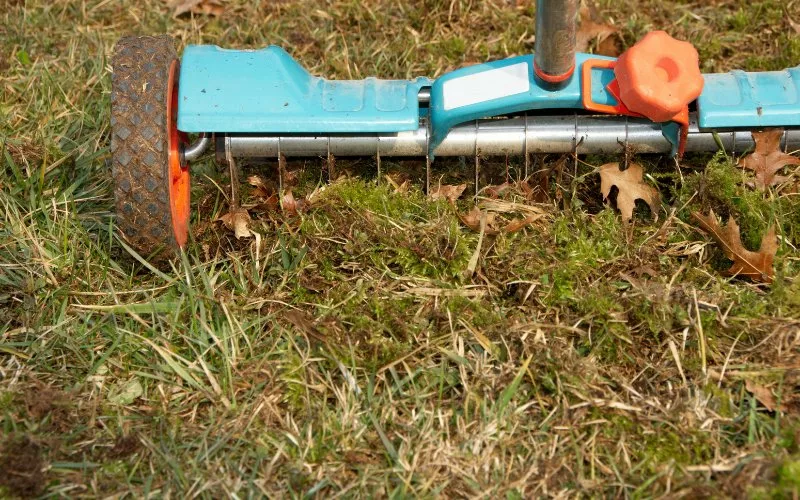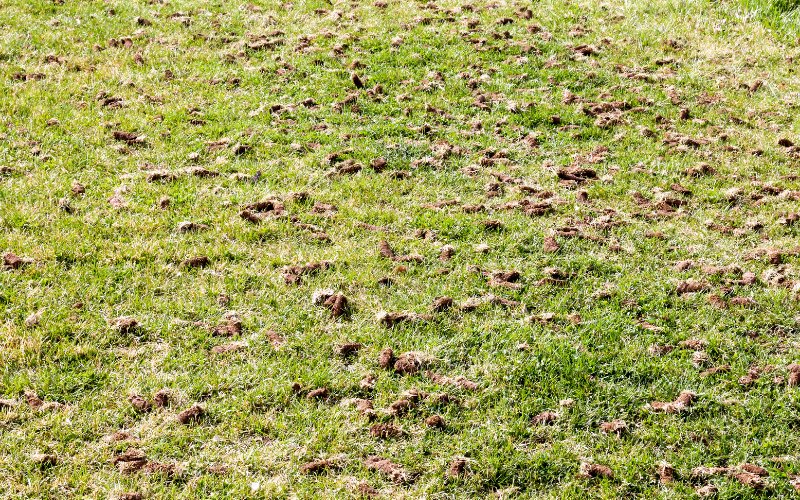Though aerating a lawn is necessary to encourage your grass to root deeply, it will inevitably cause some temporary damage to do so.
As this is the case, you need to make sure that your grass is taken care of well after each aeration. With the right care, your lawn will recover and be better than ever within just 4 to 6 weeks.
6 Things to Do After Aerating Your Lawn
Before you aerate your lawn, know your goals. Your goal could be to increase the density of your grass and fill in any thinning or bald patches.
Or your goal could be to decrease the number of weeds in your yard and increase the health of your existing grass.
Once you know your goals and what products you will need, you can come up with a plan on how to apply them.
Below are 6 things you may want to do after aerating your lawn. Remember to only apply the steps that work with your goals and consider the directions on any products you have purchased when developing your after-aeration plan.
Break Down Cores (Or Allow Them to Break Down)
If you use a type of aerator that produces cores, you’ll want them to break down as soon as possible.
If you want to speed this process up, you can use a rake to help break them up lightly or you can collect them, grind them up, and then reapply this to the lawn.
I leave the cores as they are and wait for them to break down. This allows you to disturb the lawn the least and, I believe, gives the best results.
It might not be the prettiest, but it’s less effort with better results- who can argue with that? With consistent watering, it should take about a week for the cores to break down naturally.
Overseed if Conditions are Right
Overseeding your lawn takes some planning and care. Watch your local forecast to make sure that conditions are right.
If they are and overseeding aligns with your goals, it’s a good idea to overseed directly after aerating and just before watering.
Water Your Lawn
Watering your lawn after aeration helps the ground “settle”. Watering should be done lightly, for only about 15 to 20 minutes or however long your general daily watering schedule is.
Deep watering should be avoided for the first few days after aeration to prevent water from building up inside the new pores in your lawn.
This step should be taken after seeding or applying fertilizer to your lawn if you intend to do so.
Apply Fertilizer to Your Lawn
Fertilizing your lawn is an ideal step to take after aeration, no matter the type of aeration you choose.
Fertilizing can be combined with overseeding, but it shouldn’t be done at the same time as the application of a herbicide.
Apply a Herbicide
Herbicides applied after aeration are typically pre-emergent herbicides. These should be used in spring and as early as possible for best results.
Using them after aeration can help eliminate weed seeds that are buried in the soil before they have a chance to become a problem.
Allow Your Lawn to Rest
After aerating, you should give your lawn time to recover. This means waiting to mow your lawn until it needs it.
In most cases, this means allowing your lawn to grow up to a height of 3.5″ temporarily. Traffic on the lawn should also be minimized for a week or two, if possible, to prevent compaction.
Should I Water My Lawn After Aerating?
Yes, you should water your lawn after aeration unless it is raining. Even if there is rain in the forecast for the night or day following aeration, the grass should be watered.
If it is likely to rain in the next 24 hours, water lightly directly after aeration. You don’t want the new pores you have made in your lawn to fill with water and fail to drain.
You also want to avoid the ground becoming soft enough that minor traffic on your lawn causes it to settle and compact.
Aerating Your Lawn at Specific Times of the Year
While the number of things you could do after aerating your lawn won’t change depending on the time of year, there are certain times of the year when one option or set of goals will be better than the others.
What to Do After Aerating a Lawn in Spring
Spring is the optimal time to apply a pre-emergent herbicide after aeration in any climate.
If you are having severe weed-control issues and you did not overseed after frost the previous year, a pre-emergent herbicide used after aeration can help your grass to get a head start on the season.
This is one of the few things you can do to increase the thickness of your lawn without adding more grass seed.
If you are not applying a herbicide in the spring, this is a good time to overseed your lawn, especially in warmer climates.
Alternatively, fertilizer applied to the spring may get more mileage than it would if it were applied in the fall, in colder climates.
What to Do After Aerating a Lawn in Fall
Aeration in the early fall is the best option if you want to overseed your lawn and have that seed sprout and establish itself in the same year. This can be done in warm and cold climates, provided it is early fall.
In late fall, you can still aerate but you should wait to overseed until temperatures are regularly below 35F to prevent the seeds from germinating.




After Aerating my lawn do I need to put topsoil or can I leave the cores to fill in the holes and just worry about overseeding/fertilizing the lawn. Which should I do first – seed or fertilize?
Hi Al,
After aerating your lawn, you do not need to add topsoil or any other type of “fill”. The small gaps or holes created during the aeration process allow the surrounding soil to relax into this space, and reduce compression in the area.
Once you have aerated you can seed or fertilize in any order you want. Many products on the market even offer seed and fertilizer in the same bag, to be applied simultaneously. However, it is important to remember that any fertilizer you apply at the same time as grass seed should be a light or slow-release variety to avoid overwhelming the tiny sprouts.
I hope this helps 🙂